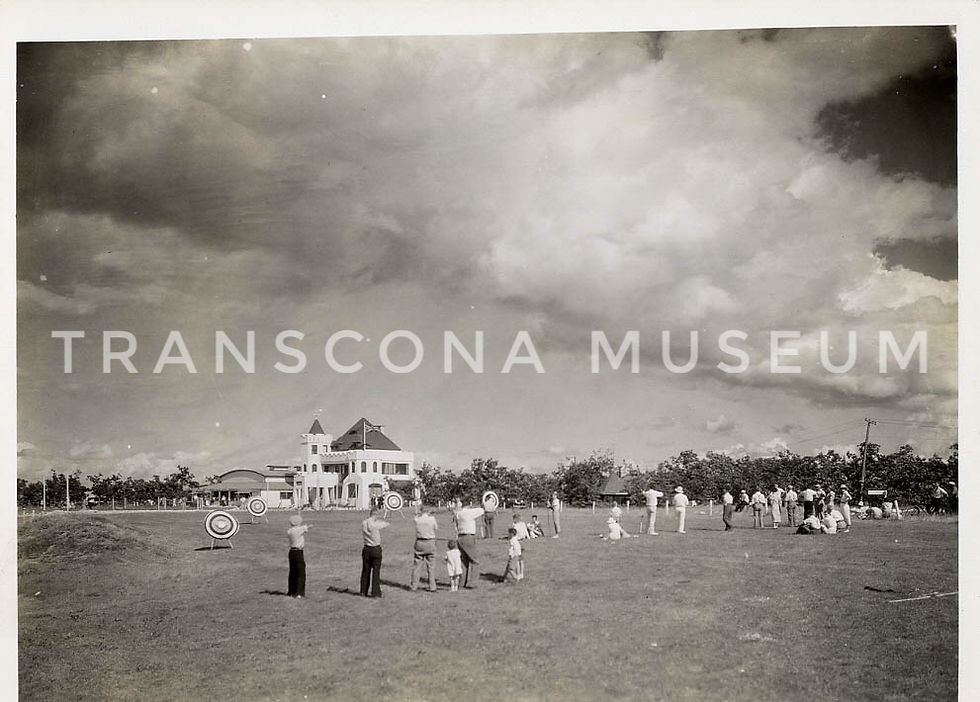The Castle and Park of Fair Hills
- May 2, 2017
- 3 min read
Updated: Feb 5, 2021


It all started with these two photographs: an image of a stone pillar entrance and a white castle. The accompanying descriptions in our collections database at the Transcona Museum simply read "Fair Hills Club, 1933 / 1935". That's not much to go on for historical research, but my curiosity quickly went into overdrive:
What was Fair Hills Club?
Where was Fair Hills Club?
What is the Transcona connection?
Surely, it would be easy to research its history. How many castles are there in Manitoba, really?
That was my starting point back in September 2016. Apparently, a massive white castle built in the Manitoba countryside is as elusive to find as a caboose on the prairies. You know it's out there somewhere, you just have to look real hard. After several months of on-and-off research, I was hopelessly stuck until I came across the book Springfield: 1st Rural Municipality in Manitoba, 1873-1973 and my research blew wide open! And now, the history of Fair Hills Park and Castle:
The Castle of E.F. Hutchings
This unique building was the personal country home of Elisha Frederick Hutchings (1855-1930), a businessman and politician. Hutchings was in the harness business and operated the highly successful Great West Saddlery Company located in the Exchange District. By 1911, Hutchings had amassed considerable wealth - an estimated $2 million. He had previously purchased land northeast of Winnipeg (Sec. 36-11-4E) and in 1912 built his new grandiose summer home.
Known as the "E.F. Hutchings Castle", this massive summer retreat boasted a fine north-facing view from Lorne Hill. Horse-drawn vehicles were driven under a portico at the front entrance. The beautiful interior contained a large dining room, sitting rooms, and a kitchen that ran the full-length of the castle's south side. There was an elaborately carved wooden banister and railing leading up the front staircase to the bedrooms where the connecting turret and balconies offered amazing views of the countryside.

The site of the castle on Lorne Hill was equally as beautiful, with woods on the northern and southern slopes and a grassy meadow of flowers on top of the hill. On a side note, Hutchings believed the property also contained oil and a drill was brought up from Texas to prove his assumptions. Oil was never found.
Fair Hills Park
After Hutchings' death in 1930, his son Harold endeavoured to preserve the property and develop a recreation center for Winnipeg residents. The castle became known as "The Chateau" and was opened to the public. Harold added a swimming pool to the west side of the castle and a dance hall to the east. Meals were offered to guests, as well as various forms of amusement including archery and horseshoes.



Known as the "Fair Hills Park" development (not the Fair Hills Club as I had been lead to believe), shares were sold but the entire undertaking proved to be unprofitable. The property was eventually sold to the Bird's Hill Sand and Gravel Company sometime around 1960. Today the castle and Fair Hills Park are gone, replaced by large gravel pits along Lorne Hill Road in West Pine Ridge, Birds Hills Provincial Park.
A Transcona Connection
Where is the Transcona connection, you ask? All the photographs the Transcona Museum has on the Fair Hills Park and the castle came to us (via donation) from Myron Kupchuk, a former Transcona resident and news photographer. Kupchuk visited Fair Hills Park in 1933 and 1935 when the recreation center was still new. The images he captured show a bevy of activity, with guests enjoying themselves to the park's amenities and natural beauty. Looking at the images, I can only imagine how novel Fair Hills Park must have been to day-trippers from Transcona and Winnipeg.
I mean, how often does one get to explore a castle on the Canadian Prairies?


Sources
Dugald Women's Institute, Springfield: 1st Rural Municipality in Manitoba, 1873-1973 (Altona: D. W. Friesen & Sons Ltd., 1974), 263-64.
"Hutchings, Elisha Frederick," Dictionary of Canadian Biography, accessed 29 April 2017.
Land Parcel Information: Square Sections, Manitoba Agricultural Services Corporation, accessed 29 April 2017.
"Market Building (Great West Saddlery Factory)," Virtual Heritage Winnipeg, accessed 29 April 2017.
"Memorable Manitobans: Elisha Frederick Hutchings (1855-1930)," Manitoba Historical Society, accessed 29 April 2017.
Myron Kupchuk Fonds, Transcona Museum Archives.

